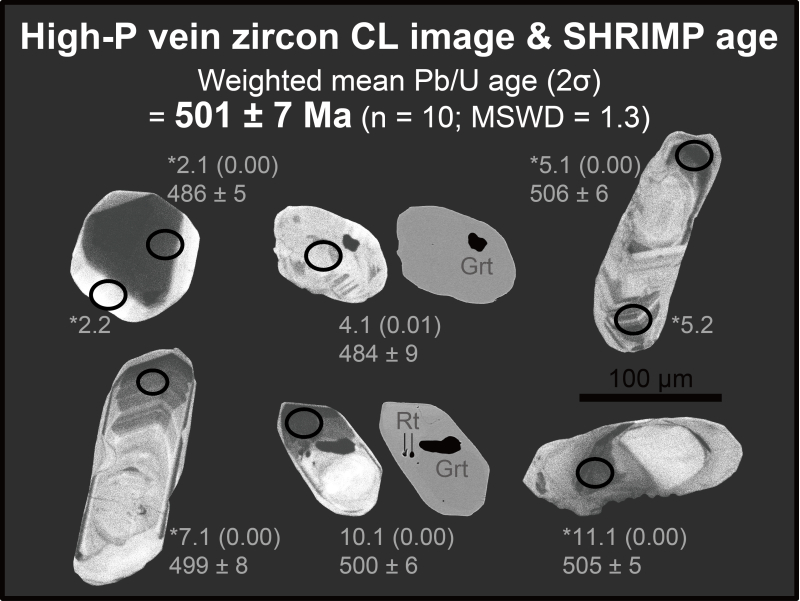
U-Pb ages and REE compositions of zircon in megacrystic phengite-bearing quartz vein from the Lanterman Range, northern Victoria Land, Antarctica
ABSTRACT

Megacrystic phengite-bearing quartz veins associated with retrogressed eclogites occur along terrane boundary zone in the northern Ross orogen, Antarctica. The vein zircons crystallized from metamorphic fluid under high-pressure (P) conditions rather than captured as xenocrysts from the host eclogites, on the basis of: (1) weak oscillatory- and fir tree-zoned cathodoluminescence textures and extremely low Th/U ratios of zircon, (2) highly steep patterns of heavy rare earth elements and weak negative to positive Eu anomaly of zircons, suggesting their growth not in equilibrium with garnet and plagioclase, respectively; and (3) the high celadonite contents of phengite megacrysts (up to 3.33 a.p.f.u. Si for O = 11). Zircon U-Pb ages dated the high-P quartz vein formation at 501 ± 7 Ma (2σ), which overlaps with time of peak metamorphism of the eclogites at c. 500–498 Ma. The zircon crystallization age and marginal breakdown of phengite megacrysts into biotite–oligoclase symplectites suggest that the high-P quartz vein formation was at near-peak to early-exhumation stages of the eclogite facies metamorphism. The similarity in depths of the vein formation and major dehydration of subducting metamafic rocks further suggests that this fluid activity would be one of possible agents responsible for arc-related magmatism in northern Victoria Land of the Ross orogen.
KEYWORDS
megacrystic phengite, quartz vein, U-Pb zircon age, REE composition, Ross orogen- Published : 2023
- Released on J-STAGE : 2023/02/04
- Received : 2022/09/21
- Accepted : 2022/12/01
- DOI : https://doi.org/10.2343/geochemj.GJ23001
- J-STAGE URL : https://www.jstage.jst.go.jp/article/geochemj/57/1/57_GJ23001/_article/-char/en
- J-Online ISSN: 1880-5973
- Print ISSN : 0016-7002
- ISSN-L : 0016-7002
All Issues
- Vol.59, 2025
- Vol.58, 2024
- Vol.57, 2023
- Vol.56, 2022
- Vol.55, 2021
- Vol.54, 2020
- Vol.53, 2019
- Vol.52, 2018
- Vol.51, 2017
- Vol.50, 2016
- Vol.49, 2015
- Vol.48, 2014
- Vol.47, 2013
- Vol.46, 2012
- Vol.45, 2011
- Vol.44, 2010
- Vol.43, 2009
- Vol.42, 2008
- Vol.41, 2007
- Vol.40, 2006
- Vol.39, 2005
- Vol.38, 2004
- Vol.37, 2003
- Vol.36, 2002
- Vol.35, 2001
- Vol.34, 2000
- Vol.33, 1999
- Vol.32, 1998
- Vol.31, 1997
- Vol.30, 1996
- Vol.29, 1995
- Vol.28, 1994
- Vol.27, 1993
- Vol.26, 1992
- Vol.25, 1991
- Vol.24, 1990
- Vol.23, 1989
- Vol.22, 1988
- Vol.21, 1987
- Vol.20, 1986
- Vol.19, 1985-1986
- Vol.18, 1984
- Vol.17, 1983
- Vol.16, 1982
- Vol.15, 1981
- Vol.14, 1980
- Vol.13, 1979
- Vol.12, 1978
- Vol.11, 1977
- Vol.10, 1976
- Vol.9, 1975
- Vol.8, 1974
- Vol.7, 1973
- Vol.6, 1972-1973
- Vol.5, 1971
- Vol.4, 1970-1971
- Vol.3, 1969-1970
- Vol.2, 1968
- Vol.1, 1966-1967




